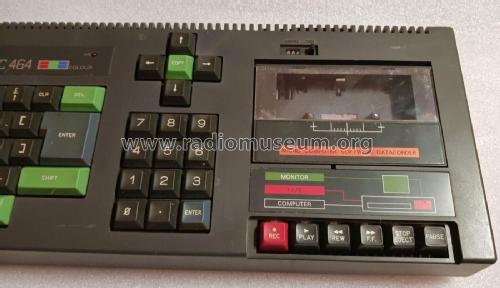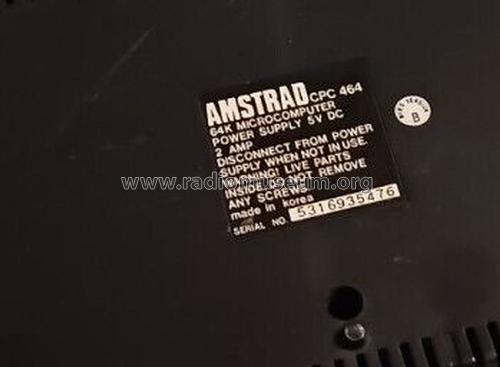Microcompter CPC 464
Amstrad; London
- Produttore / Marca
- Amstrad; London
- Anno
- 1984
- Categoria
- Elaborazione di segnali e strumenti di calcolo (Computer e moduli SP)
- Radiomuseum.org ID
- 352504
- Numero di transistor
- A semiconduttori.
- Semiconduttori
- Z80_IC AY-3-8912A
- Gamme d'onda
- - senza
- Tensioni di funzionamento
- Alimentazione a corrente alternata (CA) / DC: 5 V, AC: 50 Hz, 200 -240 Volt
- Altoparlante
- AP magnetodinamico (magnete permanente e bobina mobile)
- Materiali
- Vari materiali
- Radiomuseum.org
- Modello: Microcompter CPC 464 - Amstrad; London
- Forma
- Diverse forme (descritte nelle note).
- Annotazioni
-
Amstrad CPC 464:
The Colourful Colossus that Conquers Europe
In 1984 the British microcomputer boom was a fading echo, a flickering sunset. Yet, from the embers rises a beast: the Amstrad CPC 464, a vibrant chariot ready to whisk millions into the digital dawn.
This wasn't just a computer; it was a revolution in a box. No more tangled wires, no arcane rituals of setup. The CPC 464 was a sleek symphony of keyboard, tape deck, and processing power, all united in one glorious console. And that joystick port? A portal to pixelated playgrounds, a gateway to battles won and worlds explored.
Two cables bridged the gap to the monitor, its CRT heart humming with the promise of adventure. Plug it in, flick the switch, and behold a canvas of 27 colors, a pixelated tapestry woven by a 4-MHz Z80 maestro. From chunky 160x200 to sprawling 640x200, the CPC 464 painted a world beyond imagination.
And the sound? A three-voice symphony from the AY-3-8912's silicon soul, each bleep and bloop a pixelated psalm. Yes, later models sported a headphone jack, but who needed such frippery when the whole room could vibrate with the digital anthem of a boss vanquished?
Across Europe, more than two million surrendered to the siren song of the CPC 464. It wasn't the swiftest steed, nor the most dazzling knight, but it was theirs. A portal to worlds unseen, a passport to landscapes of pixels and polygons. Within the hum of its drives and the glow of its screen, a whisper of possibility danced: a boundless realm of adventure, just a joystick click away.
The CPC 464, now a weathered relic of a bygone era, its plastic shell whisper-faded, its tape deck a silent sentinel, still echoes in the annals of gaming history. It stands tall, a testament to the magic woven from simplicity, color, and a perfectly placed port. For in the hearts of those who journeyed with it, the vibrant colossus of the CPC 464 forever paints a world of wonder on the canvas of imagination.
Technical specifications
The CPC 464's code name during development was 'Arnold'.
The CPC 464 is powered by the Zilog Z80 processor after the original attempts to use the 6502 processor, being used in the Apple II amongst many other 8-bit computer families, failed. The Z80 runs at 4 MHz, has 64K of memory, and runs AMSDOS, Amstrad's operating system. The unit includes a built-in tape drive and the choice of a colour or green monochrome monitor.
Featured 64 KB RAM and an internal cassette deck.
The graphics, which use a Motorola 6845 chip for timing and address generation, provides 3 standard display modes, each using colours chosen from a palette of 27.
- Mode 0 - 160×200, 16 colours
- Mode 1 - 320×200, 4 colours
- Mode 2 - 640x200, 2 colours
Its sound is supplied using the General Instruments AY-3-8912 sound chip that provides 3-voice, 8-octave sound capacity through a built-in loudspeaker with volume control. Later versions of the 464 have a headphone jack that can also be used for external speakers.
The computer is powered by 5 VDC derived from the AC-powered monitor.
Suggested retail prices for the CPC 464 were £249.00 with a green screen and £359.00 with a colour monitor.
- Prezzo nel primo anno
- 249.00 GB £
- Bibliografia
- - - Manufacturers Literature
- Autore
- Modello inviato da Gary Cowans. Utilizzare "Proponi modifica" per inviare ulteriori dati.
- Altri modelli
-
In questo link sono elencati 46 modelli, di cui 39 con immagini e 2 con schemi.
Elenco delle radio e altri apparecchi della Amstrad; London






